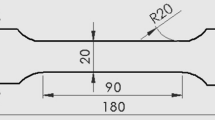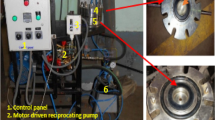Abstract
A finite element simulation of flexible bulge forming of aluminum sheet metal is carried out. The effect of rubber pad on forming capability is studied by comparing flexible bulge to hydroforming. Based on the theory of Continuum Damage Mechanics (CDM), a local approach with fully coupling between ductile damage and an anisotropic elasto-plastic model with mixed nonlinear kinematic/isotropic hardening is introduced. The model is implemented into a user-defined material (VUMAT) subroutine for the commercial finite element code ABAQUS/Explicit. A Mooney-Rivlin theory is adopted for rubber material behavior. Comparisons between both processes in terms of thickness variation, damage occurrence, and sheet formability are conducted for different rubber shores and friction. Numerical findings are in a good correlation with experiments from literature.
Similar content being viewed by others
References
Al-Qureshi HA (1971) Factors affecting the strain distribution of thin walled tubes using polyurethane rod. Mech Sei Pergamon Press 13:403–413
Al-Qureshi HA, Das MK (1974) Thin walled tube cropping using elastomer. Mach Tool Des Res 16:77–85
Belhassen L, Koubaa S, Wali M, Dammak F (2016) Numerical prediction of springback and ductile damage in rubber pad forming process of aluminum sheet metal. Int J Mech sci 117:218–226
Gao TJ, Liu Y, Chen P, Wang ZJ (2015) Analysis of bulging process of aluminum alloy by overlapping sheet metal and its formability. Trans Nonferrous Met Soc China 25: 1050–1055
Ramazeni M, Ripin ZM (2012) Combined experimental and numerical analysis of bulge test at high strain rates using split Hopkinson pressure bar apparatus. Mater Process Technol 210: 1061–1069
Ramazeni M, Ripin ZM, Ahmad R (2009) Computer aided modelling of friction in rubber pad forming process. Mater Process Technol 209:4925–4934
Ramazeni M, Ripin ZM, Ahmad R (2010) Combined experimental and numerical analysis of bulge test at high strain rates using split Hopkinson pressure bar apparatus. Manuf Sci Technol 3: 196–203
Shen Z, Liu H, Wang X, Wang C (2016) Improving the forming capability of laser dynamic forming by using rubber as a forming medium. Appl Surf Sci 369:288–298
Sun YN, Wan M, Wu XD (2012) Friction coefficient in rubber forming process of Ti-15-3 alloy. Trans Nonferrous Met Soc China 22:2952–2959
Thiruvarudchelvani S (1994) A theory for the bulging of aluminum tubes using a urethane rod. Mater Process Technol 41:311–330
Thiruvarudchelvani S, Lua AC (1991) Bulge forming of tubes with axial compressive force proportional to the hydraulic pressure. Mater Shap Technol 9:133–142
Thiruvarudchelvani S, Travis FW (1990) Tube bulging with a yrethane rod. Mater Process Technol 23:195–209
Wang ZJ, Yuan BX (2014) Numerical analysis of coupled finite element with element free Galerkin in sheet flexible die forming. Trans Nonferrous Met Soc China 24:462–469
Ahmed M, Hashmi MSJ (1997) Defects in hydraulic bulge forming of tubular components and their implication for design and control of the process. Advanced Methods in Material Processing Defects
Badreddine H, Saanouni K, Dogui A (2010) On non-associative anisotropic finite plasticity fully coupled with isotropic ductile damage for metal forming. Plasticity 117:218–226
Chamekh A, Bel Hadg Salah H, Hambli R, Gahbiche A (2006) Inverse identification using the bulge test and artificial neural networks. Mater Process Technol 177:307–310
Kacem A, Krichen AK, Manach PY (2015) Finite element analysis of hole-flanging process with various anisotropy assumptions. Adv Manuf Technol 80:11–19
Koubaa S, Mars J, Wali M, Dammak F (2017) Numerical study of anisotropic behavior of aluminum alloy subjected to dynamic perforation. Int J Impact Eng 101:105–114
Lemaitre J, Chaboche JL (1990) Mechanics of solid materials. Cambridge University Press
Liang JC, Gao S, Teng F, Yu PZ, Song XJ (2014) Flexible 3D stretch bending technology for aluminum profile. Adv Manuf Technol 71:1939–1947
Mac Donald BJ, Hashmi MSJ Finite element simulation of axisymmetric bulge forming: effects of the process on the die. European Congress on Computational Methods in Apllied Sciences and Engineering, Barcelona
Mac Donald BJ, Hashmi MSJ (2001) Three dimensional finite element simulation of bulge processing using a solid bulging medium. Finite Elem Anal Des 37:107–116
Mars J, Wali M, Jarraya A, Dammak F (2015) Finite element implementation of an orthotropic plasticity model for sheet metal in low velocity impact simulations. Thin Walled Struct 89:93–100
Mooney M (1940) A theory of large elastic deformation. Appl Phys 11:582–592
Moreira Filho LA, Al Qureshi HA (1985) Unconventional tee forming on metal tubes. Transactions of the ASME 107:392–396
Quadrin F, Santo L, Squeo EA (2010) Flexible forming of thin aluminum alloy sheets. Modern Manufacturing Technologies 11:2067–3604
Reis LC, Pratesi PA, Olivera MC, Santos AD, Fernandes JV (2016) Inverse identification of the Swift law parameters using the bulge test. Int J Mater Form. doi:10.1007/s12289-016-1296-5
Texeira P, Santos AD, Andrade Pires FM, Cesar de Sa JMA (2006) Finite element prediction of ductile fracture in sheet metal forming processes. Mater Process Technol 177:278–281
Wali M, Autay R, Mars J, Dammak F (2016) A simple integration algorithm for a non associated anisotropic plasticity model for sheet metal forming. Int J Numer Methods Eng 107:183–204
Wali M, Chouchene H, Ben Said L, Dammak F (2015) One equation integration algorithm of a generalized quadratic yield function with Chaboche non linear isotropic kinematic hardening. Int J Mech sci 92:223–232
Wang A, Zhong K, El Fakir O, Liu J, Sun C, Wang LL, Lin J, Dean T (2016) Springback analysis of AA5754 after hot stamping:experiments and FE modelling. Adv Manuf Technol 24:462–469
Xu J, Zhou Y, Cui J, Sun G, Li G (2016) Experimental study for rubber pad forming process of AZ31 magnesium alloy sheets at warm temperature. Adv Manuf Technol 89:1079–1087
Author information
Authors and Affiliations
Corresponding author
Rights and permissions
About this article
Cite this article
Koubaa, S., Belhassen, L., Wali, M. et al. Numerical investigation of the forming capability of bulge process by using rubber as a forming medium. Int J Adv Manuf Technol 92, 1839–1848 (2017). https://doi.org/10.1007/s00170-017-0278-1
Received:
Accepted:
Published:
Issue Date:
DOI: https://doi.org/10.1007/s00170-017-0278-1




